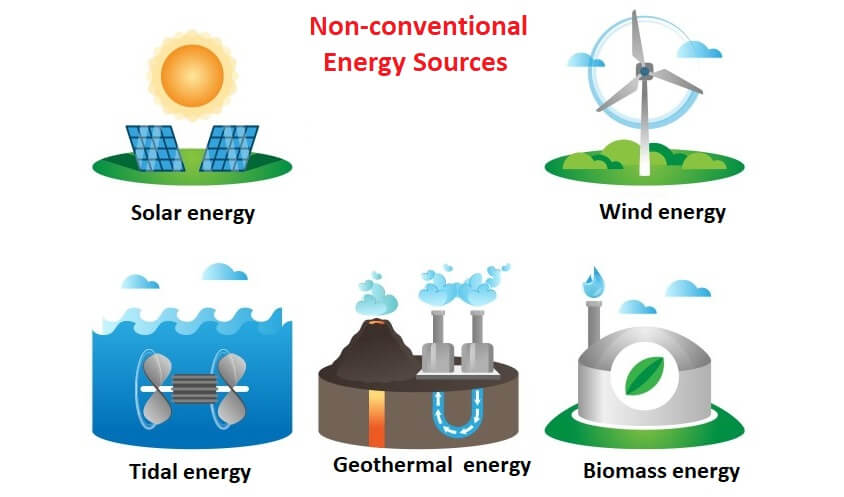Non-Conventional Sources of EnergyNon-conventional sources of energy refer to those energy sources that are replenished continuously by natural processes and are widely available. Till now, these sources are not used extensively in the world. They are infinite, natural and can be restored. For example, solar energy, wind energy, tidal energy, bio-gas, and more. They do not cause pollution so they can be used for generating clean energy with minimal waste. 
Why is non-conventional energy needed?The consumption of energy is growing day by day and we depend more on fossil fuels or conventional energy sources (coal, petroleum, etc.) than non-conventional energy sources for our energy requirements. If we keep using fossil fuels at this rate they will be depleted completely in the next few hundred years and their price will be more in the coming years. So, we need to rely more on renewable (non-conventional) sources of energy and need focus on the optimum use of non-renewable (conventional) sources of energy. The govt. of India also established a separate department for the effective exploitation of non-conventional (renewable) sources of energy. Here is the list of some of the major non-conventional sources with their detailed description. 1. Tidal EnergyAs the name suggests, it is the renewable or non-conventional energy that is produced from the natural rise and fall of ocean tides. In simple words, the flow of water during the tides produces tidal energy. The tides are produced when Earth, the sun and the moon interact gravitationally. In Tidal power plants, the energy of tides is converted into electricity. These plants are set up in areas where the sea experiences frequent waves and tides. Advantages of Tidal Energy
Tidal Energy Disadvantages: It also has some limitations that prevent from making the most of tidal energy, such as;
2. Wind EnergyIt is the energy that is obtained from the wind. The kinetic energy of wind can be used by converting it into mechanical energy such as in a windmill. In ancient times, wind energy was used in propelling ships. Today, wind energy is used for various purposes such as electricity generation wherein the kinetic energy of wind is used to move a wind turbine, a device that uses wind energy to generate electricity. The wind moves the blades of a turbine that are connected to a rotor, which spins a generator to produce electricity. Advantages of Wind Energy
Disadvantages of Wind Energy
3. Solar EnergyIt is the energy that we get from the sun, which is the biggest source of energy for us. Sun radiates very high energy constantly. Solar energy is widely harnessed in solar plants wherein solar energy is converted into electrical energy or used to generate electricity. Life on earth is not possible without solar energy, for example, green plants need sunlight to prepare their food through photosynthesis. It is clean energy as it does not cause any pollution and is also abundantly available. Uses of Solar Energy
Advantages of Solar Energy
Disadvantages of Solar Energy Silicon is used in solar cells. Although it is abundantly available, the premium quality silicon is very costly due to this the cost of installing solar panels is very high. 4. Geothermal EnergyIt refers to the energy obtained from the heat produced deep inside the Earth. It is present in the rocks and fluids present beneath the surface of Earth. The hot molten rock called magma also produces this heat. This underground source of heat can be used to generate energy such as electricity. Advantages of geothermal energy
Disadvantages of geothermal energy
5. Biomass EnergyIt is the energy obtained from living or once-living organisms. The commonly used biomass for energy are plants, woods, animals, etc. This energy can be burned to produce heat or can be converted into electricity. Biomass is organic material as it contains carbon compounds and comes from living organisms for example waste and dead remains of plants and living organisms. Further, biomass chemical composition is different in different species, however, mostly it comprises 25% lignin and 75% carbohydrates (sugars). Biomass energy is in use since ancient times when cavemen first made fire from wood for cooking and keeping warm. Today also, humans burn wood and cattle dung for cooking purposes. However, it is not environmentally friendly as it produces smoke and harmful gases that pollute the atmosphere. Advantages of Biomass Energy
Disadvantages of Biomass Energy
Next TopicMagnitude in Physics
|
 For Videos Join Our Youtube Channel: Join Now
For Videos Join Our Youtube Channel: Join Now
Feedback
- Send your Feedback to [email protected]
Help Others, Please Share










